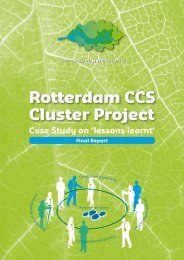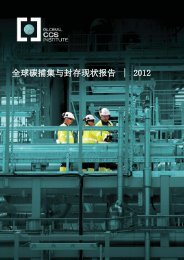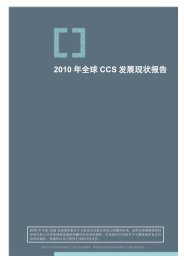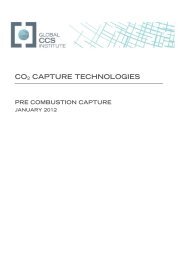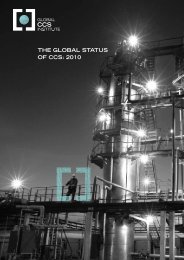Perceptions of CO2 Report - Global CCS Institute
Perceptions of CO2 Report - Global CCS Institute
Perceptions of CO2 Report - Global CCS Institute
- No tags were found...
You also want an ePaper? Increase the reach of your titles
YUMPU automatically turns print PDFs into web optimized ePapers that Google loves.
9 Conclusion and Recommendations9.1 ConclusionGovernment agencies, funders, and international energy organisations have paid a good deal <strong>of</strong>attention to <strong>CCS</strong> as part <strong>of</strong> a technology portfolio for mitigating climate change. As citizens from allbackgrounds become involved in the larger social conversation around <strong>CCS</strong>, they are currentlyassessing, judging, and forming opinions <strong>of</strong> this technology. These opinions emerge at theintersection <strong>of</strong> many societal variables, including each person’s values and beliefs regardingcarbon and climate, as well as the person’s knowledge <strong>of</strong> <strong>CCS</strong> technology itself. Beyond theseobvious dependencies lies a less obvious influence on opinions <strong>of</strong> <strong>CCS</strong>: public knowledge andperceptions <strong>of</strong> the gas itself, CO 2 .Our research in three countries identified variations in values, beliefs, knowledge, and perceptions<strong>of</strong> CO 2 . Beyond gathering this data, we attempted to relate individuals’ values and beliefs,knowledge, and perceptions around CO 2 , and knowledge <strong>of</strong> <strong>CCS</strong> to whether individuals formedmore or less favourable opinions <strong>of</strong> this technology.Overall, participants demonstrated moderate to low levels <strong>of</strong> knowledge <strong>of</strong> CO 2 ’s properties, uses,and effects. Japanese respondents demonstrated the highest levels <strong>of</strong> correct knowledge, andconfidence about that knowledge, regarding CO₂’s properties and sources, while respondents fromthe Netherlands displayed the lowest levels. While CO 2 ’s uses were generally not well known, theAustralian respondents (comprising a slightly more educated sample than the general public) hadthe greatest familiarity with its potential uses. A general level <strong>of</strong> confusion surrounds CO 2 ’s effects.In particular, it was frequently misperceived as an ozone-depleting gas with the same effect as airpollutants such as soot.This lack <strong>of</strong> knowledge <strong>of</strong> CO 2 has important implications for climate change and <strong>CCS</strong>communicators. A low level <strong>of</strong> knowledge about CO 2 and its relationship with climate change iscorrelated with climate change scepticism. This is particularly relevant for climate changescepticism in the Netherlands (de Best-Waldhober, et al., 2011; Upham & Roberts, 2011), whoserespondents recorded the lowest level <strong>of</strong> knowledge about CO 2 and the highest level <strong>of</strong> uncertaintyabout the reality <strong>of</strong> climate change during this study.Research results included many other intriguing patterns, as described in the previous chapter,which lead to several recommendations for members <strong>of</strong> the <strong>CCS</strong> industry and community.Essentially, knowledge and perceptions <strong>of</strong> CO 2 were found to be an important factor correlatingwith attitudes towards CO 2 . This outcome argues for paying increased attention to communicatingthe nature, properties, sources, uses, and effects <strong>of</strong> CO 2 while engaging public stakeholders ineducation and outreach regarding <strong>CCS</strong>.Understanding how individuals perceive carbon dioxide | 49




